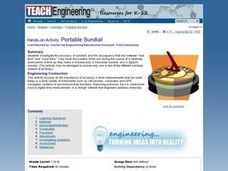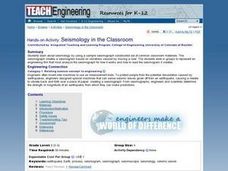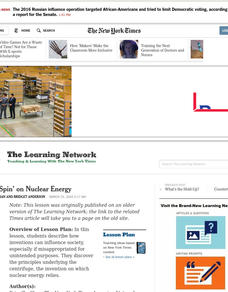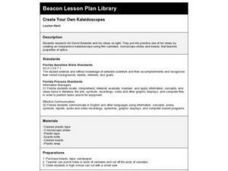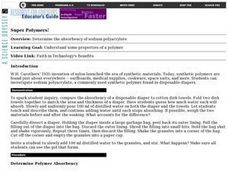Curated OER
Magnify It!
Learners explain that there are limits to what the eye can see and that a magnifying glass can help extend those limits. They examine an object with the magnifying glass and draw the size and shape of what they see as accurately as they...
Curated OER
Technology of the Deep: Experiments with Buoyant Forces
Students conduct a series of experiments to study the effects of temperature and salinity on the buoyancy of an object in water. They devise ways to make floating and sinking objects neutrally buoyant.
Curated OER
"How Sweet It Is: Awareness Today Can Defeat Diabetes Tomorrow"
Young scholars explain the importance of having a healthy body and be inspired to make better choices. They research diabetes to become aware of its symptoms, dangers, and prevention. They identify the relationship between childhood...
Curated OER
Matter
Fifth graders investigate the nature of matter and of the scientific processes associated with them in this series of lessons.
Curated OER
Design a Running Shoe for a Triathlete
Students examine the design and construction of athletic footwear. They analyze the magnitude and directions of forces on the foot and leg in different sports, interview people, and design a running shoe for a triathlete.
Curated OER
When You're Hot, You're Hot!
Eighth graders examine the development of the different temperature scales. They experiment with hot and cold temperatures.
Curated OER
All Steamed Up
Students examine the energy conversions and simple machines are involved in the operation of a steam engine. They make a replica of a small steam engine.
Curated OER
Naturally Speaking
Students identify the Earth's natural resources and classify them as renewable or non-renewable. They simulate the distribution of resources and discuss the fairness and effectiveness of the distribution. They identify ways that they use...
Curated OER
Portable Sundial
Students work together to identify the accuracy of sundials. They track the position of the sun and create a shadow plot. They discover the difference between real time and clock time.
Curated OER
Seismology in the Classroom
Students work together to use a sample seismograph. They role play the position of an engineering firm that is to analyze the machine. They discover how engineers develop new machines to take measurements.
Curated OER
Switcheroo
Students construct a simple switch and determine what objects and what types of materials can be used to close a switch in a circuit and light a light bulb.
Curated OER
The No Zone of Ozone
Young scholars explore the causes and effects of the Earth's ozone holes through discussion and an interactive simulation. Using gumdrops and toothpicks, they conduct a large-group, interactive ozone depletion model.
Curated OER
Fiber of Life
Students examine the importance of plants to individuals and society through a multi-discipline set of activities. They observe and draw different leaf structures and then create a book about trees and photosynthesis. They explore ways...
Curated OER
Natural Selection And Evolution
Seventh graders investigate the concept of natural selection and its relationship to the theory of evolution. They conduct research using a variety of resources and use the information to create a class presentation and open up the...
Curated OER
Astronomy
In this astronomy worksheet, students read a detailed text about our solar system. Students then answer 15 questions about the information presented.
Curated OER
A Model of a Scanning Tunneling Microscope
Ninth graders explain how a scanning tunneling microscope works. In this chemistry lesson, 9th graders construct atomic models and simulate how their images appear under the STM. They discuss the limitations of their atomic model.
Curated OER
A New "Spin" on Nuclear Energy
Students explain how the spin cycle of a washing machine operates. They explore other applications of the centrifuge by reading and discussing the article "Slender and Elegant, It Fuels the Bomb."
Curated OER
How is a Hot Dog Like a Shoe?
Students create and explain analogies that reveal the depth of their understanding of new concepts.
Curated OER
What is ergonomics and why is it important?
Students come up with ideas to help friendly, superintelligent space aliens adapt to this environment.
Curated OER
Create Your Own Kaleidoscopes
Seventh graders create a kaleidoscopes after researching Sir David Brewster and his ideas on light. They recognize the properties of optics from making and using the kaleidoscopes.
Curated OER
Alexander Graham Bell's Patent for the Telephone and Thomas Edison's Patent for the Electric Lamp
Students read a short biographical account about Bell and student B about Edison. Ask each pair to exchange information and determine what qualities these inventors shared. Ask students if they think all inventors share these qualities.
Curated OER
Following in Galileo's Footsteps
Students explore the findings of Galileo and research the moons of Jupiter. They construct simple telescopes, and examine the moons for themselves at a star party. They record their findings in a journal.
Curated OER
Clouds
Third graders complete various activities about clouds. They create a cloud in a lab, write a cloud story, make a cloud model and complete a webquest.
Curated OER
Super Polymers
Students investigate polymers and compare the absorbency of a disposable diaper to cotton dish towels They determine the absorbency of sodium polyacrylate.
Other popular searches
- Science Inventions 6th Grade
- Science Inventions 1st Grade
- Ancient Science Inventions
- Science Inventions 6th
- Incidence Science Inventions
- Physical Science Inventions
- Science Inventions Eliticity
- Ancience Science Inventions
- Science Inventions Eletisty
- Science Inventions Elitist
- Science Inventions Elasticity










